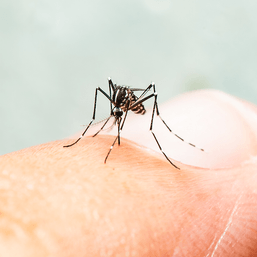SUMMARY
This is AI generated summarization, which may have errors. For context, always refer to the full article.

Claim: Eating bird’s eye chili or siling labuyo is a “tested and proven” cure for dengue.
Rating: FALSE
Why we fact-checked this: The Facebook post bearing the false claim has recently resurfaced through shares on personal accounts and Facebook groups. The original post published in 2018 has 34,000 shares, 11,000 reactions, and 2,500 comments as of writing. It was also shared on April 15 in a Facebook group with 221 members.
The post claims that siling labuyo is a “very effective” cure for dengue. The recommended means of administering the cure is as follows: “Ilubong ang siling labuyo sa bisan unsang klase na saging (fruit) parihas kagamay sa siling labuyo kanang sakto ug sayon nga matulon sa bata” (Place the bird’s eye chili in any kind of banana that is as small as the chili [or] small enough for a child to swallow easily).
The post also claims a child and a senior high school student were supposedly cured after consuming the plant, but did not provide more details or proof corroborating these statements.

The facts: The Department of Health (DOH) debunked the claim in a June 13, 2024, advisory.
“The Department of Health cautions the public against Facebook posts claiming Bird’s Eye Chili or Siling Labuyo can cure Dengue,” the advisory states.
The DOH added that currently “there is no specific treatment” for the mosquito-borne disease. The department said the best way to prevent dengue is to avoid mosquito bites, which can be done by wearing clothes that cover up as much skin as possible, applying mosquito repellent lotions or sprays, and eliminating mosquito-breeding sites.
WHO on dengue: Dengue is a “viral infection transmitted to humans through the bite of infected mosquitoes,” according to the World Health Organization. Aedes aegypti and Aedes albopictus mosquitoes are the primary carriers of the disease, but it can also be transmitted through other means, such as maternal transmission, blood products, organ donation, and blood transfusions (READ: FAST FACTS: Things to know about dengue).
ALSO ON RAPPLER
- Leila de Lima cleared of all drug charges
- Could 4th drug war conviction be the ‘last tokhang case’ in court?
- AT A GLANCE: Key features of Philippines’ new voting machines
- Negros Occidental governor sees Sara Duterte-backed challenger in 2025 polls
- How Sara Duterte led DepEd for 2 years
Similar to the DOH’s statement, the WHO said there is no specific treatment for dengue as the focus is on “alleviating pain symptoms,” such as severe abdominal pain, bleeding gums or nose, blood in vomit or stool, being very thirsty, and pale and cold skin. Dengue patients are advised to rest, drink plenty of liquids, and use acetaminophen (paracetamol) for pain, while those with severe dengue need hospitalization.
Expected rise in dengue cases: The false claim resurfaced following the DOH’s warning that a surge in dengue cases is expected due to the start of the rainy season. DOH Secretary Teodoro Herbosa said dengue is among the top three rainy season illnesses, and urged the public to get rid of mosquito breeding sites.
“If you store rain water in containers, make sure you will cover [them] properly…. We should prevent the spread of mosquitos to prevent dengue,” he said.
Previous fact checks: Rappler has debunked claims about supposed cures to common diseases:
- FACT CHECK: Claim that inhaling intestinal gas can cure disease misrepresents 2014 study
- FACT CHECK: Chavit Singson not endorsing unregistered joint pain cure
- FACT CHECK: Unregistered eye drug does not cure cataracts, macular degeneration
- FACT CHECK: Fake CNN interview of influencer Doc Alvin used in ‘joint pain cure’ ad
- FACT CHECK: ‘Diabetes cure’ ad uses unrelated photo of World War II survivor
– Shay Du/Rappler.com
Shay Du is a Rappler intern. She is an incoming fourth-year mass communication student at Silliman University. Her fact check was vetted by a member of the Rappler Research team and a senior editor.
Keep us aware of suspicious Facebook pages, groups, accounts, websites, articles, or photos in your network by contacting us at factcheck@rappler.com. Let us battle disinformation one Fact Check at a time.
Add a comment
How does this make you feel?



There are no comments yet. Add your comment to start the conversation.